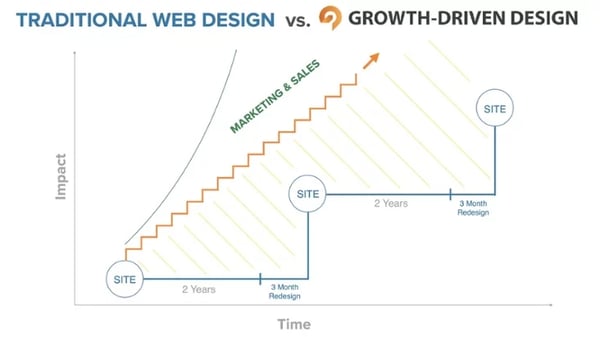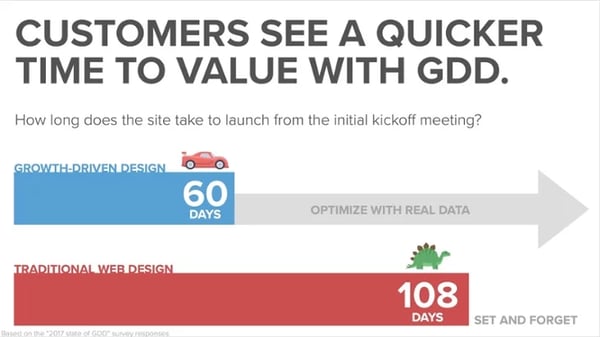If part of your business strategy is to make your website work harder for you – either by updating your existing one or perhaps completely starting from scratch – then a growth-driven design (GDD) website might be a great solution for you. And a launch pad website may well be the best approach for you.
What is a launch pad website?
Growth-Driven Design is an approach that has been around for a while, yet only now are more businesses embracing it. It’s a method that builds a website in small incremental, yet constant, steps. It encourages the designers and marketers involved to empathise with the user, observing their behaviours and patterns, then tweaking the design accordingly, to provide them with a cogent, easy and persuasive user journey.
For an agency who helps businesses create these GDD websites, the goal isn’t to produce a complete website tied up in a bow after three months, but to start showing progress much sooner with a constantly evolving, quick-start site – or a launch pad.
As the name suggests, the launch pad is merely the first version of your website – the groundwork for which all the fantastic stuff to come will launch from. GrowthDrivenDesign.com defines it as:
“The goal of the Launch Pad website is to quickly build a website that looks and performs better than what you have today, but is not your final product. Your Launch Pad is the foundation from which you collect real-user data and optimize.”

What is the goal of a launch pad website?
The idea behind a launch pad website is to help you avoid much of this instability and anxiety. Here we explore the different options for your next redesign, and discuss why creating a GDD launch pad website could be the option that you’ve been waiting for. If you want to create a higher-performing website, providing more value to both your users and your business, then look no further than a launch pad website.
What are the benefits of a launch pad website compared to the traditional website design process?
Many businesses pursue the traditional website redesign route because it is familiar to them, despite the fact it’s hugely inconvenient for most busy companies. 42% of businesses say they make impactful changes to their website once or less a year – is this often enough? If your website is your best, hardest-working, 24/7 salesperson, is this reflected in the way you invest in and develop it?

The traditional website redesign route is outlined in blue above, whereas the more modern, growth-driven design option, which includes the launch pad website, is shown in orange. While a traditional method largely ignores any elements that aren’t working well until its next review (usually at 1.5-2 year intervals), the GDD approach makes small, reactive changes to a website at regular intervals, depending on the live user data being compiled. Each individual business needs to decide which design path is better suited to them.

Traditional website redesign is typically:
- A laborious, time-consuming process
- Expensive (the average website redesign costs £15,000-£30,000)
- Requires large upfront payments which feels risky
- Goes over budget and over time frame
- Develops unforeseen obstacles
- Takes 3-6 months to complete
- Based on potentially outdated user data
- Based on what your company thinks they know about visitor behaviour.
GDD website redesign, starting with a launch pad site typically:
- Shows quick results – small, manageable changes can be actioned straight away and involves build sprints
- Has better efficiency and you are able to save time
- Costs two-three times less than the average traditional redesign
- Takes around 30 days to launch
- Is easy to tweak and change, reacting quickly to user information learnt
- Uses fewer resources at your company
- Is less disruptive to your current website visitors
- Allows targeted adaptations to be added bit by bit on an ongoing basis.
The Weidert Group explains that:
“By taking a GDD approach, you place less emphasis on perfecting the website upfront, and instead focus on creating a minimally viable product – a.k.a. your launch pad site – that can easily be tweaked and adjusted as data becomes available about how users are interacting with it.”
The idea of launching an quick start, ever-changing website can be a difficult concept to embrace for many businesses and perhaps some business leaders may not want to consider a steadily growing option, preferring to choose more of a comprehensive overhaul all at once. But if you’re keen to try something a bit different, this more user-focused approach should enable your business to develop a higher-performing website that provides better value.
Benefits of launch pad website to your business
A customer-focused business makes a better business. In the modern landscape, customer service is everything, and this doesn’t just include the way your team communicates and interacts with them, but the experience users have when they visit your website.
A website is often the first ‘sales person’ a visitor will meet from your team – and it can be a make or break experience. If you’ve got an enjoyable, easy-to-use website that looks beautiful and predicts the kind of service the visitor might want, it’s far more likely they’ll consider your product over a competitor’s with an outdated, confusing site.
In a 2017 survey, 350 agencies from around the world reported the impact their clients have seen using Growth-Driven Design vs. traditional web design:

For most businesses, the speed with which a new website can be up and running is a huge draw for approaching a GDD redesign. This means your employees and users alike will benefit from minimum disruption. During the initial strategy stage, a wish list has to be carefully drafted so you know the web pages that will be prioritised first – usually the high frequency, or most outdated pages – and the pages that will be built upon or swapped out in the weeks and months to come.
Once the most urgent elements are replaced, you can start monitoring their efficacy straight away, looking at how users are accessing the new content and start tweaking pages accordingly (while the more heavy-duty work still continues in the background). Digital 22 explains that:
“A launch pad website helps to collect real user data. This data helps to make more informed decisions during the GDD process. This way, you can have users interact with the website so behavioural data can be collected as well as feedback from those same users.”
You don’t want to get too stuck on analysis of content while you’re still building the website. Your launch pad website won’t be perfect when it’s launched – no website ever is – but the basis of this process is to make continuous improvements over time, rather than setting a complete site live and leaving it as it is – problems and all – until its next (possibly annual) review.
By learning about your website’s visitors once your launch pad site is live, you can see how they are navigating and what exactly they’re looking for. This enables you to make increasingly informed marketing decisions and website improvements.
The beauty of the GDD model is that it suits any business, from any sector, with any type of website; changes are made according to your own wishlist, as well as the key areas identified by your marketing agency.
Ultimately, a higher-performing website that provides more value to both your users and your business is the result... and one we don’t think you’ll look back from.
Stay Updated with Our Latest Insights
Get expert HubSpot tips and integration strategies delivered to your inbox.




